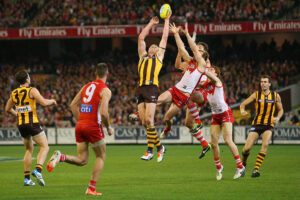
Each year the AFL releases data on the seasons injuries and we now have access to many years’ worth of data on injuries. We can assume that the AFL data is quite like what we see at the local club level. Some of this injury data is:
• The Hip/Groin/Thigh is the most commonly injured area (29% of all new injuries), with hamstring strains accounting 14% of all new injuries.
• Injuries to the Hip/Groin/Thigh account for 34.9 (22%) missed games, with hamstrings accounting for 19.1 (12%).
• Shin/ankle/foot is also commonly injured and accounts for 26% of all new injuries. These injuries account for 42.4 (27%) of games missed.
• Knee injuries, whilst only accounting for 5.3 (14%) of injuries account for a significant number of games missed (37.4 games or 24%).
• Lower limb injuries account for 68% of all injuries.
• Many of the remaining injuries are thought to be secondary to contact, for example fractures of the forearm, wrist and hand.
• Concussions have been on a steady rise in recent years. This is thought to be due to increased recording and raised awareness of the effects of concussion.
The most common footy injuries seen by Michael Christofis are: hamstring, groin, hip & shoulder. These injuries are also the most prevalent at the elite level, accounting for a quarter of the injuries seen in AFL players in the 2015 season. As the injury type and prevalence amongst AFL players is like that seen at the local level, much of what we learn from the AFL injuries can be implemented into rehab programs to help our local clubs.
SO, WHAT CAN BE DONE FOR INJURY PREVENTION?
We would prefer to prevent a footy injury from occurring in the first place rather than treating it after it has already happened. As the risk of further injury increases after an initial injury, injury prevention should be an essential part of training. This is something that is already occurring in AFL clubs & what we apply in our practice. There has been a significant amount of both time and money put into researching injury prevention to determine what works and what doesn’t, these include…
• Pre-season
• Warm-up strategies
• Sport-specific drills
• Strength and Conditioning
• Joint range of movement; Muscle flexibility; Balance & Proprioception
If you, a family member, friend or team mate do happen to get injured on the footy field having the injury assessed & treated as quickly as possible by your local Physiotherapist will give you the best chances of a speedy recovery & get you back on the field playing the game you love.
